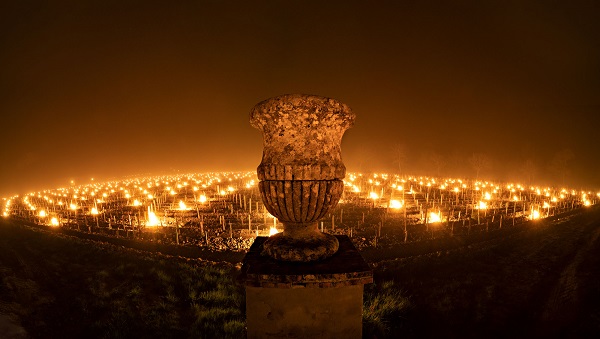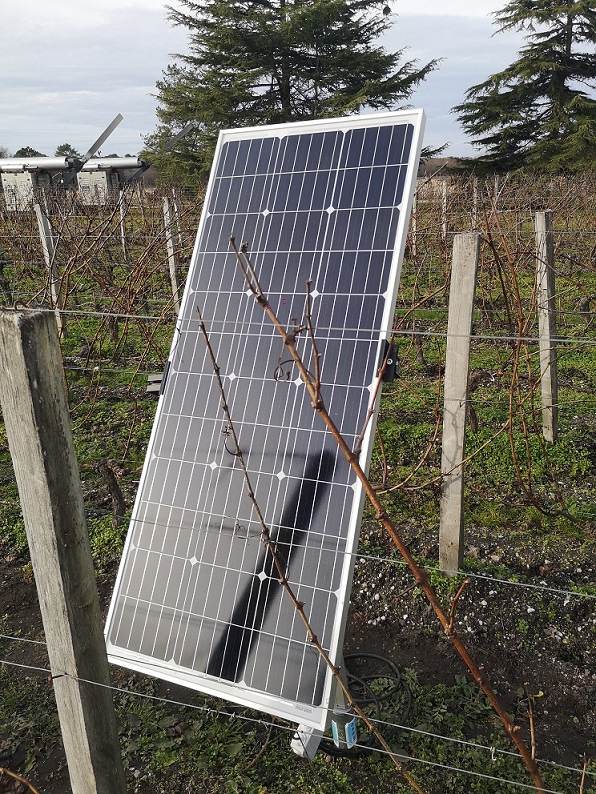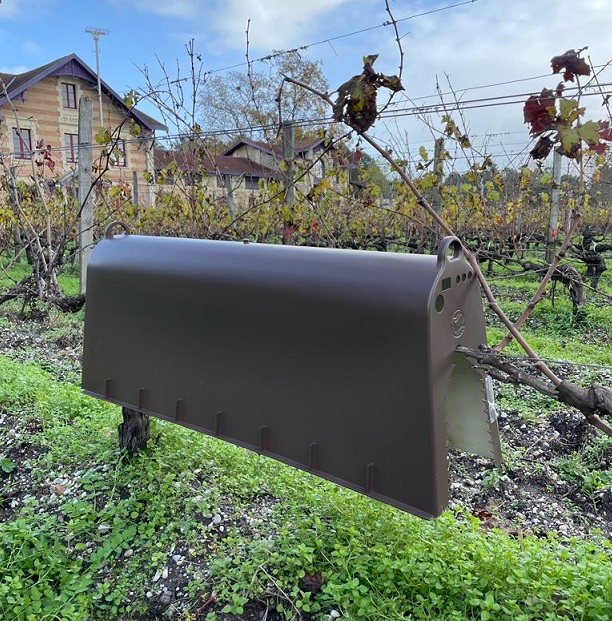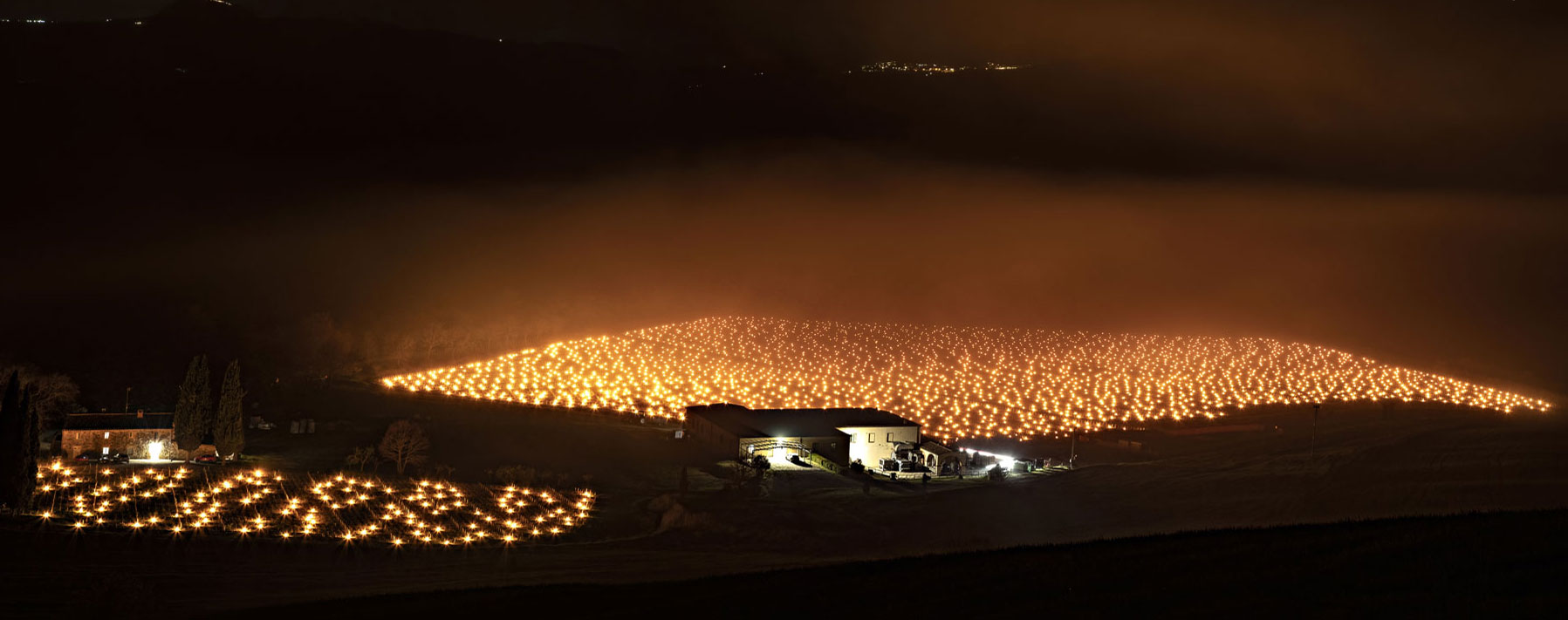This was the sight for two nights at Tenuta di Trinoro in Val d’Orcia, Tuscany, last April.
The whole winery team of 36 came to the vineyard to fight a wave of frost that had come down the mountain to threaten the fragile buds just beginning to sprout. They set 3,000 large candles – buckets filled with wax – along the rows during the day, and piled stacks of firewood around the vineyards. Then they returned at night to monitor the falling temperature. As it headed towards zero, they set the firewood and candles alight.

This kept the air around the plants above 0°C, while in other vineyards the temperature dropped as low as -4.5°C, devastating yields in many vineyards in Europe.
In the morning, at 9.45am, the team left for home, after their eight-hour shift.
Burning air-polluting candles, braziers or bales of straw is becoming a more common sight in vineyards as the likelihood of early budbursts is increasing at a rate faster than the decrease in potential spring cold spells.
"There is an apparent paradox: global warming can lead to increased frost damage!" Robert Vautard, senior scientist at the French National Centre for Scientific Research and director of the Institut Pierre-Simon Laplace, stated last year after frosts destroyed buds on grapevines in Bordeaux, Burgundy, the Languedoc and Rhône valley. "Our results show that climate change is making both the growing season start earlier and frosts become warmer, but the former effect dominates over the latter. The consequence is that vineyards grow and mature faster now, but this leaves them more exposed to eventual colder snaps."
Current alternatives to candles include moving the air using helicopters or wind machines, electric heating wires, or spraying the buds and young shoots with water from overhead sprinklers to cover them with a layer of ice. All are expensive options and come with a large carbon footprint.
That’s why I'm curious about two novel, more sustainable and economic methods currently under development.
The sweet alternative
In Italy, researchers at the University of Perugia are studying the application of an organic coating made of sugar and straw. The carbon footprint of this method is estimated at 316kg CO2 equivalent emissions per hectare, saving an equivalent of 69,375kg CO2 eq in emissions compared to burning wood in the vineyard.This more sustainable and innovative method has been developed at the university's CIRIAF (Interuniversity Center on Pollution and Environment Mauro Felli) and tested at lab scale with encouraging results. The method consists of an insulation coating made of organic cotton candy and straw sprayed on the buds and young shoots. As the sugar elements leave the heated sugar processing machine and hit the air, they turn solid. The addition of 20% straw improves the insulating layer performance. Further research is being carried out to assess the implementation of the method in the field at diverse elevations, site exposition, wind, and vegetation cover.
They estimate the vineyard operation will take about 4.6 hours per hectare.
The 316kg of CO2 largely comes from the production of the sugar beet:
- 86% concerns the sugar beet, 70.6% being from its production;
- 5% for the application process (emissions);
- About 4.5% for the transportation of labourers;
- About 3% for the straw;
- The rest is for packaging.
The researchers say the CO2 eq emissions are 220 times higher for the wood-burning practice and the human toxicity is 20 times higher for the wood-burning system. Their literature review suggests there will be cost savings, too:
- Assuming 1ha of vineyard requires 200-400 fire spots, and each fire spot consumes 80kg of wood, it could cost €3,200 per hectare for one single frost event, excluding other operation costs. Fuel burners could cost €3,600/ha. The cost of bougies, according to Alistair Nesbitt, can be estimated at €2,900/ha.
The researchers admit further study is required regarding methods for distributing the sugar-coating, its durability and the type of sugar employed.
In a separate trial in Bordeaux, a biostimulant derived from apple extracts was sprayed on Merlot vines. It helped to mitigate the effects of early April frost – increasing the temperature in the buds from the control blocks’ -3.5°C to -2.8°C in the block treated with PEL 102 36 hours before the frost event. Two months after the frost event, significantly better shoot growth and fruit set were observed than in the control group, namely 7.7 clusters compared to 6.1 per vine.
Solar-powered anti-frost lamps


Another trial in Bordeaux that could be significant concerns solar-powered anti-frost lamps. Marketing of the units (above) begins this month (December 2023) after the success of the prototypes in field tests.
“We want to reduce the environmental impact by using renewable energies,” young inventor Déborah Ducamp told Canopy.
Déborah joined Château Le Sartre in Léognan, Bordeaux, as part of the first intake of Bernard Magrez’s incubator project, which supports “young start-ups today in order to reinvent the wine world of tomorrow”.
Her design comprises an on-board solar panel, a battery, a weather station and six heaters to protect six vines. Made from 100% French recycled materials, the unit is attached to the trellis wire above the fruit cane and is triggered when the temperature drops below the set point defined by the winegrower. “During our trials in Léognan, we managed to gain up to 7°C,” she says.
In field trials in the spring, a dozen modules were installed in several French wine regions to properly calibrate the system. “The objective is to guarantee a temperature of at least 0°C under the module for the entire duration of the frost – 7 to 8 hours maximum, with a complete battery recharge from one night to the next,” she says.
After the tests, she redesigned the panels so they don’t interfere with vineyard operations, such as spraying.
Other sustainable solutions that may mitigate the impact of spring frosts:
- Training the vines higher off the ground;
- Late pruning or double pruning.













.png)






